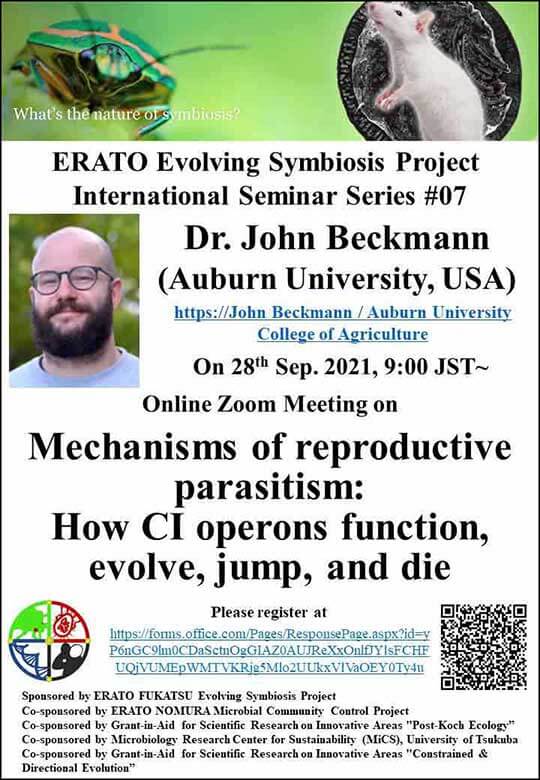ERATO Evolving Symbiosis Project International Seminar Series #07
Dr. John Beckmann(Auburn University, USA)
“Mechanisms of reproductive parasitism: How CI operons function, evolve, jump, and die”

Abstract:Wolbachia are obligate intracellular bacteria. They are the most common known insect endosymbiont. One cause of their abundance is reproductive manipulation. Wolbachia cause cytoplasmic incompatibility (CI). The CI phenotype was first observed in the 1930’s and characterized in the 1960’s. Recent discoveries have identified two gene operons that induce CI. The operons behave as a toxin antidote (TA) system. The toxin has either deubiquitylating or nuclease enzymatic domains that induce the CI phenotype; in some cases both enzyme domains are present. Recent proteomic studies have identified nuclear import factors (karyopherins) and protamine histone exchange chaperones (P32) as target substrates. The operons that induce CI have also been found in close sister bacteria Rickettsia and Orientia. In Rickettsia the operons appear on plasmids which suggests that CI evolved from a simple plasmid TA system. Furthermore, the operons are capable of horizontal gene transfer and have recently “jumped” into pathogenic Orientia tsutsugamushi. The Orientia operon is active when tested in transgenic Drosophila models. Notably, Trombiculid mite vectors exhibit Orientia dependent parthenogenesis. This observation suggests a new hypothesis that parthenogenesis induction and CI might share a common mechanistic foundation, built upon these operons. Finally, evolutionary theory predicts that selection does not maintain these operons, once fixed in a population. However, they persist in nature by “jumping” to new organisms. Operons that do not jump eventually pseudogenize by N-terminal deletions in the toxin gene and/or mutations reducing toxin enzymatic efficiency.
ERATO Evolving Symbiosis Project International Seminar Series #07
Sponsored by ERATO FUKATSU Evolving Symbiosis Project
https://www.jst.go.jp/erato/fukatsu/english/
Co-sponsored by ERATO NOMURA Microbial Community Control Project
https://www.jst.go.jp/erato/nomura/en/index.html
Co-sponsored by Grant-in-Aid for Scientific Research on Innovative Areas "Post-Koch Ecology”
https://postkoch.jp/about/
Co-sponsored by Microbiology Research Center for Sustainability (MiCS), University of Tsukuba
https://www.mics.tsukuba.ac.jp/en
Co-sponsored by Grant-in-Aid for Scientific Research on Innovative Areas "Constrained & Directional Evolution”
http://constrained-evo.org/english.html


